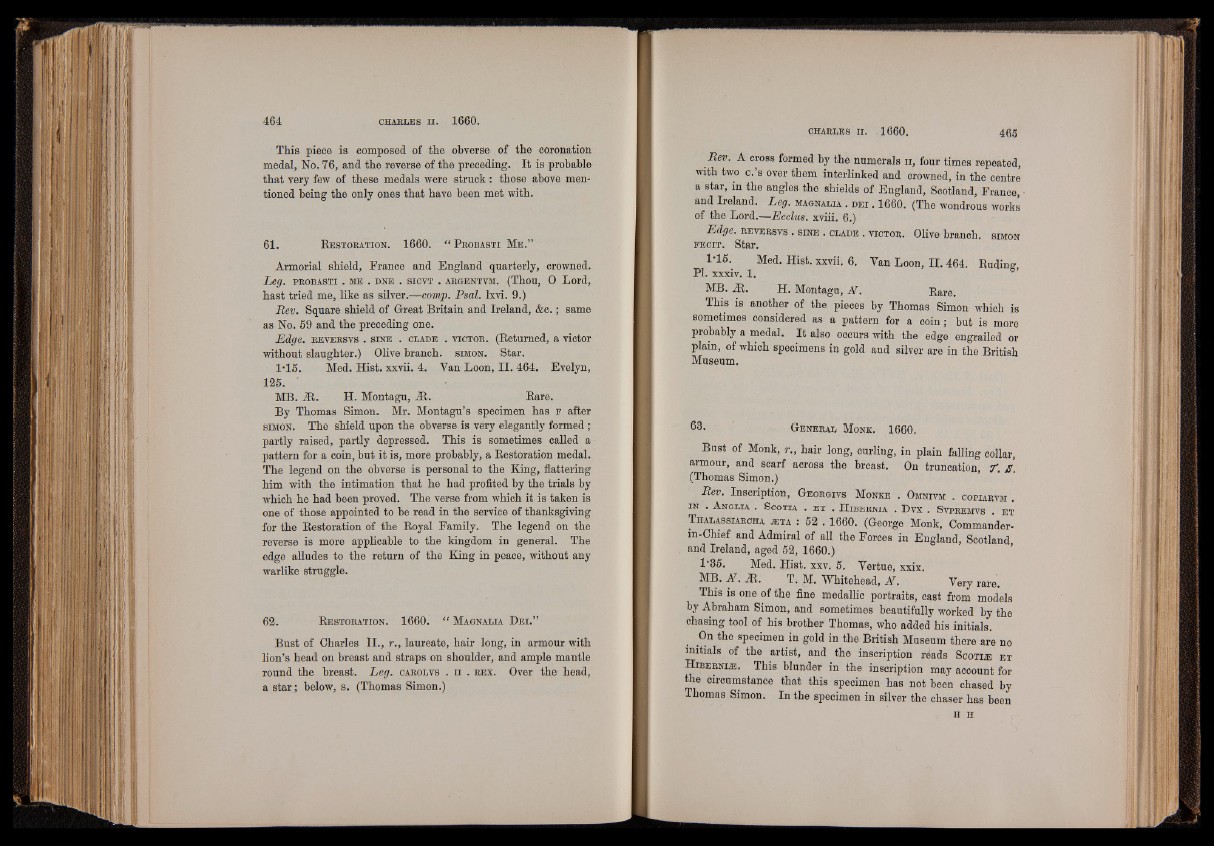
This piece is composed of the obverse of the coronation
medal, No. 76, and the reverse of the preceding. It is probable
that very few of these medals were struck: those above mentioned
being the only ones that have been met with.
61. R e s t o r a t io n . 1660. “ P r o b a s t i M e . ”
Armorial shield, France and England quarterly, crowned.
Leg. p r o b a s t i . m e . d n e . s icv t . a r g en tvm . (Thou, 0 Lord,
hast tried me, like as silver.—comp. Psal. lxvi. 9.)
Rev. Square shield of Great Britain and Ireland, &c.; same
as No. 59 and the preceding one.
Edge, r e v e r sv s . s in e . c lade . v ic to r . (Returned, a victor
without slaughter.) Olive branch, s im o n . Star.
1-15. Med. Hist, xxvii. 4. Van Loon, II. 464. Evelyn,
125. '
MB. R . H. Montagu, R . Rare.
By Thomas Simon. Mr. Montagu’s specimen has f after
s im o n . The shield upon the obverse is very elegantly formed ;
partly raised, partly depressed. This is sometimes called a
pattern for a coin, but it is, more probably, a Restoration medal.
The legend on the obverse is personal to the King, flattering
him with the intimation that he had profited by the trials by
which he had been proved. The verse from which it is taken is
one of those appointed to be read in the service of thanksgiving
for the Restoration of the Royal Family. The legend on the
reverse is more applicable to the kingdom in general. The
edge alludes to the return of the King in peace, without any
warlike struggle.
62. R e s t o r a t io n . 1660. “ M agnalia D e i . ”
Bust of Charles II., r., laureate, hair long, in armour with
lion’s head on breast and straps on shoulder, and ample mantle
round the breast. Leg. carolvs . n . r e x . Over the head,
a star; below, s. (Thomas Simon.)
Rev. A cross formed by the numerals n, four times repeated,
with two c. s over them interlinked and crowned, in the centre
a star, in the angles the shields of England, Scotland, France,
and Ireland. Leg. magnalia . d e i . 1660. (The wondrous works
of the Lord.—Ecclus. xviii. 6.)
Edge, r e v e r sv s . s in e . clade . v ic to r . Olive branch, simon
f e c it . Star.
1-15. Med. Hist, xxvii. 6. Van Loon, II. 464. Ruding,
PI. xxxiv. 1.
MB. R . H. Montagu, AF. Rare.
This is another of the pieces by Thomas Simon which is
sometimes considered as a pattern for a coin; but is more
probably a medal. It also occurs with the edge engrailed or
plain, of which specimens in gold and silver are in the British
Museum.
G e n e r a l M o n k . 1660.
Bust of Monk, r., hair long, curling, in plain falling collar,
armour, and scarf across the breast. On truncation, 7“, A,
(Thomas Simon.)
Rev. Inscription, G e o r g iv s M o nke . Omnivm . copiarvm .
in . A n g l ia . S cotia . e t . H ib e r n ia . Dvx . S vpr em v s . e t
T halass iaroha -e t a : 52 . 1660. (George Monk, Commander-
in-Chief and Admiral of all the Forces in England, Scotland
and Ireland, aged 52, 1660.) ’
1'85. Med. Hist. xxv. 5. Vertue, xxix.
MB. X . R . T. M. Whitehead, N . Very rare.
This is one of the fine medallic portraits, cast from models
by Abraham Simon, and sometimes beautifully worked by the
chasing tool of his brother Thomas, who added his initials.
On the specimen in gold in the British Museum there are no
initials of the artist, and the inscription r<kds S c o t l e e t
H ib e r n l e . This blunder in the inscription may account for
the circumstance that this specimen has not heen chased by
Thomas Simon. In the specimen in silver the chaser has been
H H